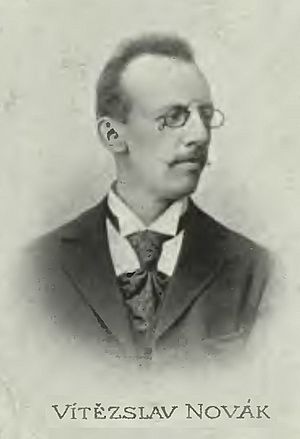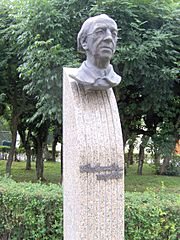Vítězslav Novák facts for kids
Quick facts for kids
Vítězslav Novák
|
|
|---|---|

Novák in 1899
|
|
| Born |
Viktor Novák
5 December 1870 Kamenice nad Lipou, Bohemia
|
| Died | 18 July 1949 (aged 78) Skuteč
|
| Education | Prague Conservatory |
| Occupation |
|
| Organization | Prague Conservatory |
Vítězslav Augustín Rudolf Novák (born December 5, 1870 – died July 18, 1949) was a famous Czech composer. He also taught music at the Prague Conservatory. His music style was part of the "neo-romantic" tradition, which means it was like the Romantic music of the past but with new ideas. His work is also seen as an important example of Czech "modernism," showing new and different ways to create music. After Czechoslovakia became independent in 1918, Novák helped build a strong Czech identity through his art. He wrote many pieces, including operas and music for orchestras.
About Vítězslav Novák
Early Life and Music Studies
Novák was born as Viktor Novák in Kamenice nad Lipou, a small town in Southern Bohemia. In 1872, his family moved to Počátky. There, young Novák started learning music. He studied the violin with Antonín Šilhan and the piano with Marie Krejčová.
After his father passed away in 1882, his family moved to Jindřichův Hradec. Novák continued his studies at grammar school. Today, an elementary school in that town is named after him.
Later, as a teenager, he moved to Prague to study at the Prague Conservatory. He changed his first name to Vítězslav. This was a common choice for people of his generation to show their strong Czech identity.
At the conservatory, he studied piano. He also took special composition classes with the famous composer Antonín Dvořák. His classmates included other future composers like Josef Suk and Oskar Nedbal.
When Dvořák went to America for three years (1892–1895), Novák continued his studies with Karel Stecker. After graduating, around 1900, Novák started writing music that was different from his teachers' styles. His music began to move towards the new "modernist" movement.
New Musical Ideas
In the late 1890s, Novák started looking for new musical influences. He went beyond the popular styles of composers like Richard Wagner and Johannes Brahms. He became interested in folk music from Moravia and Slovakia. At that time, these areas were seen as less modern than Prague.
He also explored musical Impressionism, a style that creates a mood or atmosphere. Novák later said he developed these ideas on his own, even though they were similar to the music of Debussy. His techniques included using two different keys at the same time (called bitonality) and unusual harmonies.
After seeing the opera Salome in Prague in 1906, Novák also became a big fan of Richard Strauss's music. This influence stayed with him throughout his career.
Teaching and Challenges
Around 1900, Novák began teaching composition privately. From 1909 to 1920, he taught at the Prague Conservatory. Teaching sometimes took up more of his time than composing.
Some of his students became famous composers themselves, like Alois Hába and Vítězslava Kaprálová. During this time, Novák was part of a discussion group called the Podskalská filharmonie. This group shared new ideas about modern music.
In 1912, Novák faced a challenge. He became involved in a disagreement with Zdeněk Nejedlý, a music critic. When Novák spoke out against Nejedlý's negative comments about Dvořák, Nejedlý started strongly criticizing Novák's music. This criticism deeply affected Novák and caused a difficult period in his creative life.
Role in Czech Culture
When Czechoslovakia became an independent country in 1918, Novák focused on helping to organize culture in the new government. He worked to make the Conservatory more Czech and less German. He became the new head of the Czech-only institution.
He held various leadership roles until he retired. During this time, he continued to teach advanced composition classes. This allowed him to influence a new generation of musicians.
Later Years and Legacy
In the 1930s, Novák had a period of new artistic energy. He premiered some large musical works. After the Nazi occupation began in 1939, Novák, who was retired, gained respect for his patriotic music. These works were a musical way of showing resistance and boosting morale.
After World War II, he wrote a long memoir called O sobě a jiných (Of Myself and Others). He passed away in Skuteč in Eastern Bohemia, where he had spent many of his final years.
Novák's Music Style
Novák's music kept some parts of the late-Romantic style throughout his life. His earliest published work was a piano trio, but he wrote other pieces before that. These early works showed influences from composers like Robert Schumann and Grieg.
Folk Music and Impressionism
After graduating, Novák's music began to show influences from Moravian and Slovak folk music. He started collecting and studying these folk songs in the late 1890s. Within ten years, he had blended the rhythms and melodies of these songs into his own unique style. You can hear this change in his Second String Quartet (1905) and the important piano work, Sonata Eroica (1900).
Next, he was influenced by French impressionism. This style first appeared in his song cycle Melancholie (1901). It is most clear in his tone poem O věčné touze (Of the Eternal Longing, 1905).
Grand Works and Operas
At the same time, his music became more grand and powerful. This can be heard in the Slovak-inspired tone poem V Tatrách (In the Tatras, 1902). This combined with his discovery of Richard Strauss's music. The result was the tone poem, Toman a lesní Panna (Toman and the Wood Nymph, 1907).
Many people, including critics, believed the peak of his composing career was in 1910. He completed two major works: Pan, a long, five-part tone poem for solo piano, and Bouře (The Tempest). The Tempest was a huge cantata for singers, choir, and orchestra, lasting almost an hour. Its detailed musical storytelling showed Novák's growing interest in opera.
Later Compositions
His conflict with the critic Nejedlý changed how Novák approached composing. He became more worried about his music being rejected. The negative public reaction to the orchestral version of Pan (1912) and another cantata, Svatební košile ("The Wedding Shirt", 1913), caused him to doubt himself.
Novák tried to improve the situation by writing two operas about Czech history. These were patriotic works during wartime. Zvíkovský rarášek (The Zvíkov Imp, 1915) was a comedy. Karlštejn (Karlštejn castle, 1916) was a more serious work. Both received mixed reviews, but Karlštejn became a regular part of Czech opera houses. These operas showed Novák's use of bitonality, which means using two different keys at the same time.
After Czechoslovakia became independent in 1918, Novák wrote several patriotic pieces. These were dedicated to the president and the Czechoslovak army. This led to a more traditional style in his music. The artistic experiments he had done from 1900 to 1916 almost disappeared.
His last two operas, Lucerna (The Lantern, 1923) and Dědův odkaz (The grandfather's legacy, 1926), were mostly criticized. Novák became very bitter towards those who opposed him.
Renewal and Patriotic Music
With two ballet-pantomimes completed in 1928–29, Signorina Gioventù and Nikotina, Novák regained some respect. The way he layered orchestral sounds, including different rhythms and even references to tango, impressed younger composers.
In the 1930s, he returned to writing chamber music. He also created large works like the epic choral and orchestral piece, Podzimní symfonie (Autumn Symphony, 1934).
During the Nazi occupation, Novák's patriotic works made him highly regarded again. These included symphonic poems like De Profundis (1941) and Svatováclavský triptych (Saint Wenceslas Triptych, 1942). His Májová symfonie (May Symphony, 1945) was dedicated to Joseph Stalin as a liberator. In his final years, he mainly wrote choral works based on folk songs from Southern Bohemia.
Main Musical Works
Dramatic Works
- Zvíkovský rarášek, Op. 49, comic opera, 1913-14
- Karlštejn, Op. 50, opera, 1914-15
- Lucerna, Op. 56, musical fairytale, 1919-22
- Dedův odkaz (Grandfather's legacy), Op. 57, opera, 1922-25
- Signorina Gioventu, Op. 68, ballet pantomime, 1926-28
- Nikotina, Op. 59, ballet pantomime, 1929
- Žižka, Op.78, incidental music, 1948
Symphonies
- Podzimní symfonie, Op. 62 (Autumn Symphony), for choirs and large orchestra, 1931-1934;
- Allegro appassionato
- Bacchanale
- 'Adagio
- Májová symfonie, Op. 73 (May Symphony), for soloists, choir, and orchestra, 1943;
- Andante sostenuto
- Andante
- Alla marcia funebre
Orchestral Works
- Korzár (The Corsair), overture after Byron, 1892
- Serenade, Op. 9, for small orchestra, 1894-1895, revised 1949
- Piano Concerto in E minor, 1895
- Allegro energico
- Andante con sentimento
- Allegro giusto
- Maryša, Op. 18, dramatic overture, 1898
- V Tatrách (In the Tatra mountains), Op. 26, symphonic poem, 1902
- Slovácká svita, Op. 32 (Slovak Suite), for small orchestra,1903
- O večné touze, Op. 33 (Eternal Longing), after Hans Christian Andersen, 1903-05
- 2 Valašské tance, Op. 34, 1904
- Serenade, Op. 36, for small orchestra, 1905
- Toman a lesní panna, Op. 40 (Toman and the Wood Nymph), symphonic poem, 1906-07
- Lady Godiva, Op. 41, overture after the tragedy by Vrchlicky, 1907
- Pan, Op. 43, symphonic poem, 1910
- Jihočeská svita (South Bohemian Suite), Op. 64, 1936-37
- De Profundis, Op. 67, symphonic poem‚ 1941
- Svatováclavský triptych, Op. 70 (St. Wenceslas triptych), for organ and orchestra, 1941
Voice and Orchestra
- Melancholické písně o lásce (Melancholic songs about love), Op. 38, for soprano and orchestra, 1906
- Bouře, Op. 42 (de storm), voor solisten, koor en orkest, 1908-10
- Svatební košile, Op. 48, after Erben, for soloists, choir and orchestra, 1912-13
- 3 české zpěvy, Op. 53 (3 Czech songs), for male choir and orchestra, 1918
- 2 romances, Op. 63 (on a text by Jan Neruda), 1934
- In memoriam, Op. 65, 4 songs for mezzo-soprano, string orchestra, harp, and tamtam, 1936-37
- 2 legendy na slova lidové‚ poesie moravské (2 legends on Moravian folk poetry), Op. 76, for mezzo-soprano and orchestra, 1944
- Hvězdy, for female choir and orchestra, 1949
Images for kids
See also
 In Spanish: Vítězslav Novák para niños
In Spanish: Vítězslav Novák para niños



